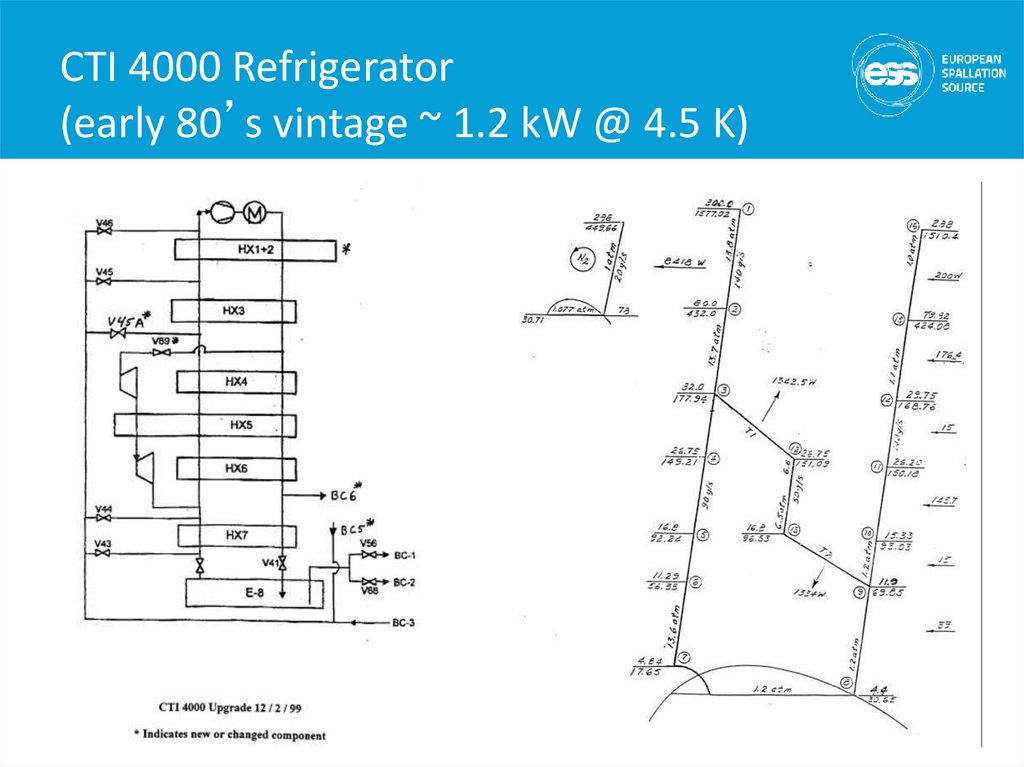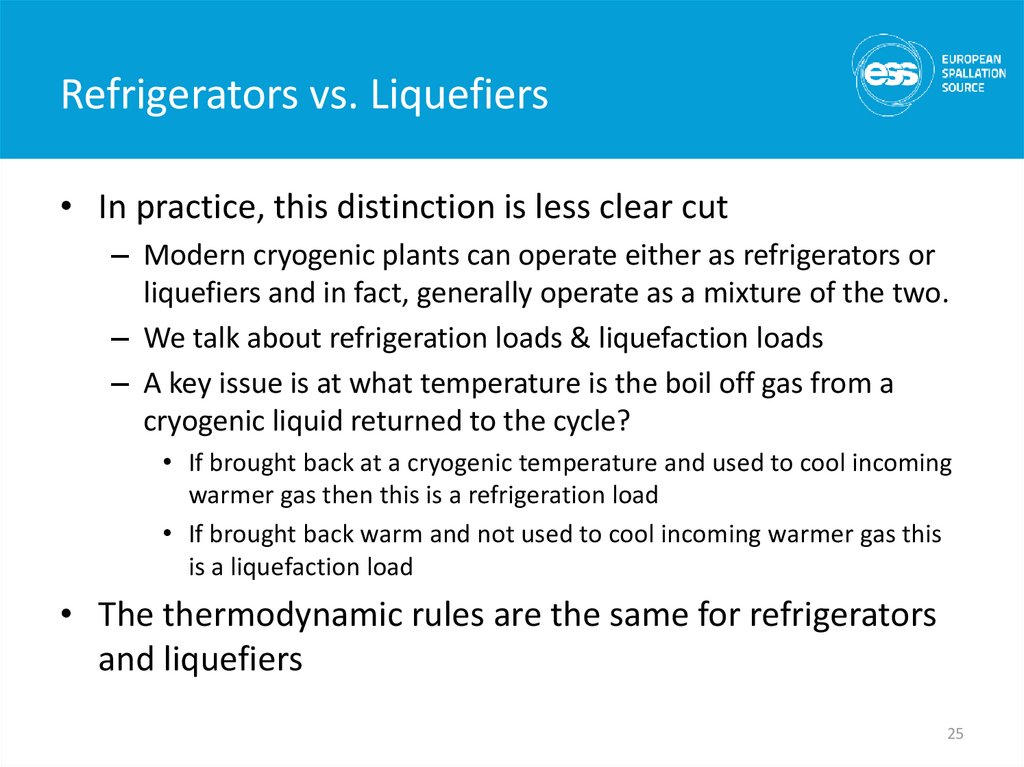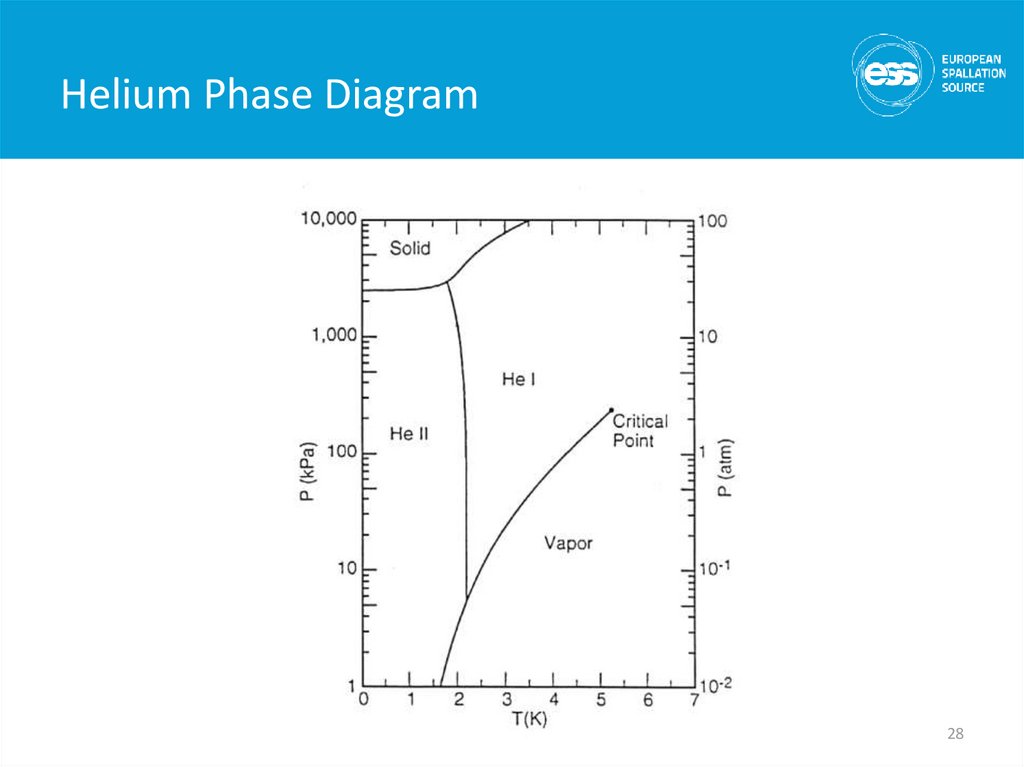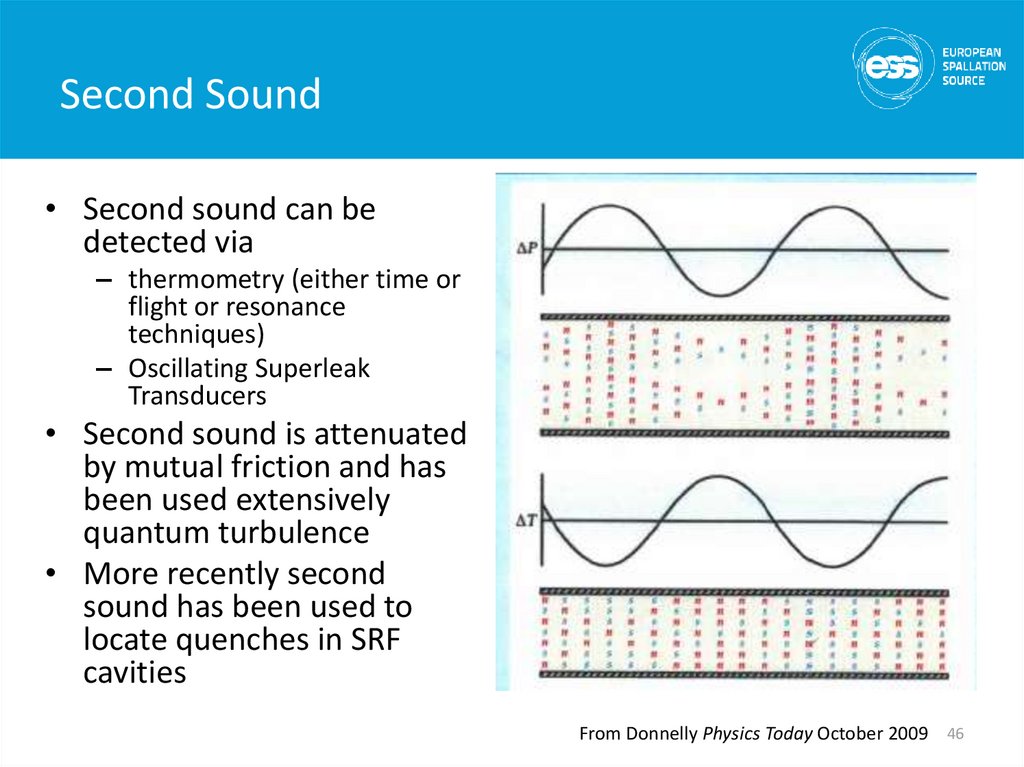Similar presentations:
Cryogenics & Cryomodules. Part 1: Catching Cold
1. Cryogenics & Cryomodules Part 1: Catching Cold
Cryogenics & CryomodulesPart 1: Catching Cold
J. G. Weisend II
Deputy Head of Accelerator Projects
www.europeanspallationsource.se
11 September 2015
2. Goal
• The goal of this tutorial is to provide a background incryogenics suitable for workers in the field of
Superconducting RF along with pointers for further
study
– At the end of today, you should understand the basics of
cryogenics and cryomodules as they apply to SRF systems
• The tutorial is divided into 2 logical parts: one on
making things cold i.e. refrigeration systems & He II
(Catching Cold) and 1 on maintaining things cold i.e.
Cryostats and cryomodules (Keeping Cold)
2
3. Outline
Part 1: Catching Cold– Introduction To Cryogenics
– Basic refrigeration processes
• Isenthalpic (Joule-Thomson)
• Isentropic expansion
– Carnot Cycle, COP and FOM
– Collins Cycle and Modern Refrigeration Plants
– He II (Superfluid Helium)
Definition and use in SRF systems
Two-Fluid Model
Heat Transfer
Fluid mechanics
Second Sound
He II Refrigeration Systems
3
4. Outline
Part 2: Keeping Cold– Cryogenic Safety
• Oxygen Deficiency Hazards
• Pressure safety
• High Level Guidelines
– Cryostats and Cryomodules
• Definitions
• Materials
• Thermal Insulation Systems
– Conduction
– Convection
– Radiation
• Cryomodule Examples
4
5. What is Cryogenics ?
• Cryogenics is the science & engineering of phenomena that occur attemperatures below 120 K
• Cryogenic applications include:
– Air Separation
– MRI Systems
– Cooling of superconducting magnets for research: HEP, Fusion, High Field
Labs
– Liquefaction of gases allows transport at high densities and low pressure:
LNG, oxygen, nitrogen, argon, hydrogen, helium
– Space Applications: LOX, LH2, sensor cooling typically below 3 K
– Biomedical: cryosurgery, cell preservation)
– Other physics applications: Dark matter searches, calorimeters, EXO
– Aerospace and military – IR sensing
– SRF Systems
• While this tutorial will only cover one of these applications, the
basic principles taught apply to all of them
5
6. Some Examples
67. Superconducting RF is Very Popular
NameAccelerator Type
Lab
T (K)
Refrigeration Capacity
Status
CEBAF
Electron Linac
JLab
2.1
4.2 kW @ 2.1 K
Operating
12 GeV Upgrade
Electron Linac
Jlab
2.1
4.2 kW @ 2.1 K
Operating
ESS
Proton Linac
ESS
2.0
3 kW @ 2 K
Under
Construction
SNS
H- Linac
ORNL
2.1
2.4 kW @ 2.1 K
Operating
E Linac
Electron Linac
TRIUMF
2.0
288 L/Hr
Operating
S-DALINAC
Electron Linac
TU Darmstadt
2.0
120 W @ 2.0 K
Operating
ERL
Electron Linac
Cornell
1.8
7.5 kW @ 1.8 K
Proposed
XFEL
Electron Linac
DESY
2.0
5 -8
40-80
2.5 kW @ 2 K
4 kW@ 5 -8 K
26 kW @ 40-80 K
Under
construction
ATLAS
Heavy Ion Linac
ANL
4.7
1.2 kW @4.7
Operating
LCLS II
Accelerator
SLAC
2.1 K
4 kW @ 2 K
14 kW @ 35 -55 K
1.2 kW @ 5 – 8 K
Design (2019)
TESLA Tech
ISAC - II
Heavy Ion Linac
TRIUMF
4
FRIB
Heavy Ion Linac
MSU
2.1
4.5
33/55
Operating
3.6 k W @ 2.1 K
4.5 kW @ 4.5 K
20 kW @ 35/55 K
Under
Construction 7
8. Catching Cold
• Before we get involved in thermodynamic cycles, let’s go overthe basics
• There are really only a few ways in which to make a pure fluid
such as helium colder
– Cause the fluid to do work by making it expand against a piston or
turbine while keeping it thermally isolated from the outside
environment Isentropic Expansion
– Transfer heat from the fluid to a colder surface
– Cause the fluid to do “internal work” by expanding it through a valve
while keeping it thermally isolated Isenthalpic Expansion
• Joule-Thomson expansion (more later)
– Once the fluid is a liquid, reduce the pressure above the fluid below
atmospheric pressure thus reducing the saturation temperature
• All modern cryogenic plants do the first 3. Ones that provide
cooling below 4.2 K also do the last item
8
9. Generic T-S diagram Showing Isenthalps, Isobars and 2 Phase Region
Enthalpyh = u + pv
9
10. Carnot Cycle
• This is an ideal cycle: all processes are reversible– Entropy is only changed by absorbing or removing heat at
constant temperature
– 2nd law of Thermodynamics, in a reversible process dQ = -TdS
• The Carnot Consists of 4 steps
– Compress the working fluid isothermally at TH (1-2)
– Expand the working fluid isentropically from TH to TC (2-3)
– Absorb heat into the working fluid isothermally and reversibly at
TC (3-4)
– Compress the working fluid isentropically from TC to TH (4-1)
– Note isentropically = reversibly and adiabatically
10
11. Carnot Cycle
TTH
TC
1
2
3
4
Q
S
s1
s2
How do we describe the performance of such a cycle?
11
12. Coefficient of Performance & the Carnot Cycle
Coefficient of Performance& the Carnot Cycle
• Coefficient of Performance: the heat absorbed from the
cold sink divided by the net work required to remove this
heat
Q
a
m
Qa
COP
Wnet
Wnet
m
– Minus sign takes into account that the heat absorbed
by the cycle is positive while the work done is
negative
– For the ideal (and in practice unachievable) Carnot
cycle it can be shown that:
COP
Qa
Wnet
TC
TH TC
12
13. Coefficient of Performance & the Carnot Cycle
Coefficient of Performance& the Carnot Cycle
• For a plant operating between room 300 K and 4.2 K, the Carnot COP is
4.2/( 300 – 4.2) or 0.0142
• The Carnot cycle is the ideal case. It is the best you can do without violating the
laws of thermodynamics
• Note that the form of the Carnot COP shows that you have a better COP (thus a
more efficient process or refrigerator) if TC is large
It is always thermodynamically more efficient to intercept heat (provide
cooling) at higher temperatures
This fact drives a lot of cryogenic design
In practice, we generally discuss the inverse of the COP because this allows us
to describe the number of watts of work required to provide 1 Watt of cooling at a
given temperature. For a Carnot cycle providing cooling at 4.2 K. This is 70 W/W
• People will frequently and incorrectly refer to this as a COP as well
13
14. Carnot Cycles & the Real World
Carnot Cycles & the Real World• Can we build a real machine using a Carnot cycle? In a word NO
• Why?
Compressing a fluid isothermally is very hard to achieve, Normally the
fluid is compressed and then cooled back down to 300 K
Expanding or compressing fluid isentropically is basically impossible
We can absorb heat into a boiling fluid isothermally but not with out
irreversible losses
• How close can we get to Carnot? We define the Figure of Merit
(FOM) as:
COP
FOM
COPCarnot
We also speak in terms of “percent Carnot” i.e. FOM of 0.2 is 20%
Carnot
14
15. The real world is sometimes not kind to cryogenic engineers
• These are state of the art helium refrigerators. Note that the best of them(for LHC) runs at about 220 W/W or a FOM of 0.318 or at 32% Carnot
16. Practical Impact of Plant Performance
• How much power does it take to operate a large cryogenicrefrigeration plant?
• AT ESS we expect to have a refrigeration plant capable of
removing as much as 9.5 kW at 4.5 K. The FOM of the plant
is expected to be 0.26
If the plant operates as expected this means we will need:
(66/0.26) x 9500 = 2.4 MW of mechanical power
• We are adding some additional margin to the electrical
power requirements and have asked for at least 2.6 MW
available for powering the compressors
16
17. Joule-Thomson Expansion
Isenthalpic (h=constant) expansionFluid cools as is it is expanded at constant enthalpy
through a valve
However, depending on both the fluid and the
temperature, such an expansion can also cause
heating.
T
mj
Define the Joule-Thomson expansion coefficient
P h
mj must be positive for cooling to occur
Cooling by JT expansion has some advantages
• No moving parts
• Can easily handle two-phase mixtures
17
18. JT Inversion Curve & Maximum Inversion Temperatures
JT Inversion Curve & MaximumInversion Temperatures
Fluid
Max Inversion
Temperature (K)
Nitrogen
623
Argon
723
Hydrogen
202
He
43
• Maximum inversion temperature for
helium is 43 K
• Note that below ~ 2 K He again
warms on JT expansion
• Many fluids, such as N2 can be
liquefied using JT expansion – JT cycle
Inversion curve for Helium
18
19. Practical Large Scale Helium Refrigerators
Modern large scale Helium refrigerators/liquefiers use avariation of the Claude cycle known as the Collins cycle
The key difference between these cycles and the JT cycle is
the addition of expansion engines (pistons or turbines) that
the fluid does work against and thus cools
The process through these expansion engines may be
idealized as Isentropic (s = constant) expansion
• Cooling occurs at any temperature
• DT for a given DP is much larger than for isenthalpic expansion
Claude cycle = 1 expansion engine, Collins cycle = multiple
expansion engines
• The post WW II development of the Collins liquefier revolutionized
laboratory research in cryogenics
19
20. Claude Cycle
From Cryogenic SystemsR. Barron
20
21. Collins Cycle
• Cycle consists of :1) Compression to ~ 16 Bar with cooling back to 300 K + oil
removal
2) Cooling of high pressure gas with LN2
3) Isentropic expansion via 2 or more expansion engines
4) Cooling of high pressure gas by the cold returning low
pressure stream
5) Isenthalpic expansion through JT valve
6) Return of gas to compressors at just above 1 Bar
21
22. CTI 4000 Refrigerator (early 80’s vintage ~ 1.2 kW @ 4.5 K)
2223. LHC 4.5 K Refrigeration Plant 18 kW @ 4.5 K – produced in ~ 2004 1of 8 required (4 from Linde, 4 from Air Liquide)
Note:Large number of expansion turbines
– some in series with HP stream
Medium pressure return
Heat loads at intermediate
temperatures
Designed to have high % Carnot
(roughly 30%)
23
24. Refrigerators vs. Liquefiers
• Refrigerators are closed cycle systems– They provide cooling and can create liquids but all the mass flow
is returned to the start of the cycle
– Such systems are said to have “balanced flow”
• Liquefiers are open cycle systems
– They provide a liquid which is then drawn off and used
elsewhere
– These have “unbalanced flows” the amount of mass returned to
the start of the cycle is less than the amount that started by the
mass that was converted to liquid.
– In order to keep the cycle running this mass would have to be
added as room temperature gas.
24
25. Refrigerators vs. Liquefiers
• In practice, this distinction is less clear cut– Modern cryogenic plants can operate either as refrigerators or
liquefiers and in fact, generally operate as a mixture of the two.
– We talk about refrigeration loads & liquefaction loads
– A key issue is at what temperature is the boil off gas from a
cryogenic liquid returned to the cycle?
• If brought back at a cryogenic temperature and used to cool incoming
warmer gas then this is a refrigeration load
• If brought back warm and not used to cool incoming warmer gas this
is a liquefaction load
• The thermodynamic rules are the same for refrigerators
and liquefiers
25
26. Consider the cooling of a superconducting magnet and its current leads
2627. He II (Superfluid Helium)
• 2nd liquid phase of helium (hence He II)• Phase transition is 2nd order (no latent heat) but
there is a discontinuity in the specific heat (l
transition)
• Tlmax = 2.2 K
• Has unique thermal and fluid properties
– High effective thermal conductivity
– Zero viscosity under certain conditions
27
28. Helium Phase Diagram
2829. Why Use He II in SRF Systems?
• The biggest single advantage is the lower temperature (<4.2 K)– Lower temperature means lower BCS losses in cavities, size of effect is RF
frequency dependent
– He II refrigeration is more costly (due to Carnot & machine inefficiencies)
– Generally speaking, removing 1 W at 2 K is the equivalent of removing 3 W
at 4.2 K
– There is a point at which the gain from lower BCS losses is better than the
additional cost of refrigeration
• An additional advantage is the very efficient heat transfer
mechanism in He II
– This results in no bulk boiling which reduces microphonics
• The majority of new SRF systems operate in the He II regime
29
30. What is He II ?
• A “Bose – Einstein like” Condensate– A fraction of atoms in He II have condensed to the
quantum ground state
– He II was the first of these condensates discovered
– The only one that has significant industrial applications
• The properties of He II can be understood via the two
fluid model
30
31. Two Fluid Model
• He II can be thought of afluid with two
interpenetrating
components:
– Normal fluid component
• Finite viscosity
• Finite entropy
– Superfluid component
• Zero viscosity
• Zero entropy
• The interaction of these
components can explain
He II behavior
Relative Densities of Superfluid and Normal
fluid components
(From Helium Cryogenics – Van Sciver)
31
32. Quantized Vortices (or does He II at 1 K rotate in a bucket)
• At 1 K He II is almost entirely the superfluid component and thus hasalmost 0 viscosity. This would imply that He at 1 K in a spinning
bucket wouldn’t rotate but it does. What’s the answer?
– The vortices are quantized:
h
C Vs dl n
m
• Solves rotating bucket problem
– In the body of the fluid:
2Vs 0
2Vs 0
• This has been experimentally observed
• The quantized vortices in the superfluid component are an
important part of heat transfer mechanism in He II
– At the wall:
32
33. Direct Observation of Quantized Vortices via Electron Trapping
3334. Heat Transfer in He II
• The basic mechanism is internal convection:Vn
Q
Vs
TH
TL
• No net mass flow
• Note that this is not conduction or classical convection but
an entirely different heat transfer mechanism
• This can be extremely efficient (more than 1000x better
than conduction through copper)
34
35. Heat Transfer in He II
• There are 2 heat transfer regimes:– Vs < V sc
sd T dT
q
2
n
dx
– Vs > V sc
• Mutual Friction Regime (quantized vortices interact with the viscosity of the
normal component
dT
1
q f P, T
dx
1
3
• As V sc ~ d-1/4 (cgs units) the mutual friction regime is most
applicable in engineering applications of He II
35
36. Heat Conductivity Function
3637. He II Heat Transfer Limits
• In pressurized He II: T h must be less than T l• Thus the peak heat flux q* is:
q* L 3
1
• At 1.9 K and 1 bar :
q*L1/3 ~ 15 kW/m5/3
Tl
Tb
f 1 T dt
1
3
37
38. Peak Heat Flux (q*) in Pressurized He II
3839. Limits on He II Heat Transfer
• In saturated He II, the limit isgiven by the local saturation
temperature & the degree of
local subcooling
• In the ILC cavity He vessel
this works out to about 1
W/cm2 or ~ 30 W total
through the connection tube
– More heat than that would
require a redesign
• Exceeding the heat transfer
limits in either the saturated
or pressurized case results in
conversion to He I and
boiling at the heated surface
39
40. Surface Heat Transfer
• Heat transfer from a surface into He II is completely dominated by afundamental inefficiency in moving energy from the surface to the
fluid
• This effect exists but is not important in standard convection
problems
– Normally we assume Tw = Tfw but this is not true in the case of He II
• This surface heat transfer effect is described by Kapitza Conductance
– For q < 1 kW/m2
– For q > 1 kW/m2
q hK DTS
q a(Tsm Tbm )
h k, a and m are empirical and dependent on material, temperature and surface condition
40
41. Surface Heat Transfer
m~3Kapitza conductance is
not dependent on
helium flow rate
41
42. Forced Convection and He II
If Kapitza Conductance is independent of flow rate does forced convection in He II make anysense?
Yes! Forced convection has the effect of reducing the maximum temperature in the He II
and thus allowing more heat to be transferred before reaching the peak heat flux
42
43. He II Fluid Dynamics
Despite the presence of the superfluid component, inalmost all engineering applications He II behaves as a
classical fluid. This includes :
• Pump performance
» Except cavitation in saturated He II
• Pressure drop in tubes, valves, bellows and fittings
• Flow metering techniques
This is likely a result of the quantized vortices in the
superfluid component being coupled via mutual friction to
the normal fluid viscosity
However, keep in mind that the unique heat transfer
properties still exist as described.
43
44. He II Fluid Dynamics
• He II does behave differently in cases of:– Film flow
– Porous plugs
– Two – phase flow (liquid/vapor) due to the large density
difference between liquid and vapor in the case of He II
44
45. Second Sound
• The two-fluid model predicts and experiments show that temperature wavesmay be established in the He II due to oscillations in the local entropy. These
temperature waves are known as second sound as they are analogous to
density waves caused by pressure oscillations.
• Recall that the superfluid component has zero entropy
From Helium Cryogenics S.W. Van Sciver (2013)
45
46. Second Sound
• Second sound can bedetected via
– thermometry (either time or
flight or resonance
techniques)
– Oscillating Superleak
Transducers
• Second sound is attenuated
by mutual friction and has
been used extensively
quantum turbulence
• More recently second
sound has been used to
locate quenches in SRF
cavities
From Donnelly Physics Today October 2009 46
47. Typical He II Refrigeration System
He II (Superfluid Helium) S. W. Van Sciver,in Handbook of Cryogenic Engineering,
There 2 approaches to providing He II
To SRF systems:
1) Create the He II for a given string
of components and distribute it
(LHC, XFEL, CEBAF)
• Less expensive, fewer
warm/cold transitions
2) Create the He II at each
cryomodule (12 GeV, SNS, ESS,
FRIB)
• Less Heat load to 2 K
• Better flexibility
47
48. He II Summary
• He II is a unique fluid that displays quantum behavioron a macroscopic scale
• He II has significant applications in large scale
cryogenics for scientific research
• Despite its unique properties, the use of He II in
industrial scale engineering applications is well
understood and significant experience exists: Tore
Supra, LHC, Jlab, NASA
48

























































